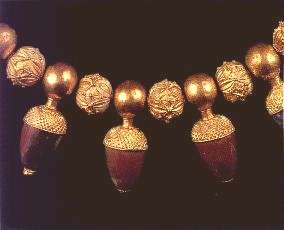

|
Gold and Glass
Length 44.3 cm.
height of acorns 3.3, 3.5 and 3.9 cm.
weight 141.1 qr.
Usak Museum
The necklace is composed of twenty floral beads and eighteen plain beads with acorn pendants. Each floral bead is decorated with two six-petal rosettes that radiate from perforations at rosite ends of the bead and make contact at the petal tips. The petals are segmented, with hatched borders; some have a central line of stippling, others have a plain raised centres. The quadrangular spaces between petals contain smaller rosettes, Each with four hatched petals. Granulation spheres ring each perforation and accent the tips and junctures of petals in the six-petal rosettes and the centres of the four-petal rosettes. Each plain bead is connected to an acorn by a short cylindrical stem made of gold sheet which has a moulding at either end and job is soldered to bead and acorn. The acorn cups have incised cross-hatching and beaded wire at the rims. Of the surviving fifteen acorn nuts, ten are gold. three are opaque red glas (one partly blackened), and two are blue glass (of which the outer end of one is missing). The remaining three caps have no nuts, but two of these contain a green glass substance which is apparently the filling of the gold nuts. The gold nuts have a circular groove around a raised centre at the tips. The glass nuts have gold tips in the form of a flat collar around a hemispherical boss, surrounded by a circle of beaded wire, and attached by a pin inserted into the perforated nut.
|
Acorns were common motifs in jewellery and other sumptuary of the Greek world. There are well known 6th and 5th century examples from Eretria and Nymphaeum. and also examples from Anatolia. Cold acorn pendants were found at Gordion in cremation burial A. dating to the third quarter of 6th century BC. From Tumulus B4 (dated to 530-510 BC) at Bayindir in northern Lycia were recovered silver acorn pendants. An ivory female figure from Tumulus D at Bayindir, of an early. probably 7th century date. is believed to be depicted wearing an acorn necklace, as is the girl holding the hand of a second ivory figurine from the same tumulus. A similar necklace can be seen on a kore from Sardis.
Class acorns are not common; a mid 4th century BC glass acorn pendant in the British Museum (CR 1857.12-20.43) came from the Mausoleum at Halicarnassos.Simpler plain bead and acorn pendant ensembles were made from punches like nos. 201 and 202. Analogous floral beads also occur on the hippocamp brooch (no.112) and on a necklace with seed like pendants from the so-called Tomb of the Carian Princess at Halicarnassos, of a late 5th or 4th century date. The treatment of the petals is similar to that of seed like pendants from the Great Blitznitza tomb group. also of a later date. A remarkable unprovenanced parallel is a necklace in the Batya and Elie Borowski Collection in Jerusalem which has beech nut pendants comparable to those of necklace no.133. and large floral beads virtually identical to those of the acorn necklace no. 108. From each floral bead is suspended a triad of chains which have terminals very similar to those of the hippocamp brooch no.112. The necklace has been dated to the 4th century BC although the criteria for this are not clear, and one might be tempted to propose an earlier date on the evidence of the Usak-Gure comparisons.
|
|









